英语词汇学教程课件第6章English Lexicology 6上
英语词汇学教程全套课件精选文档

VS
Common suffixes include "ness", "- tion", "- ism", "- ment", "- ity", etc.
Root word
Root word is the basic form of vocabulary, usually a monosyllabic word that can be used independently. For example, "act" is a root word that can add different prefixes and suffixes to form other words, such as "action", "react", "activate".
The Importance of English Lexicology
English Lexicology is crucial for language learners because it helps them understand the meaning and usage of words, improving their vocabulary and language comprehension
It is a branch of linguistics that focuses on the vocabulary of a specific language, providing a systematic and comprehensive understanding of words and their meanings
英语词汇学教程ppt课件第6章

Sometimes when a word consisting of two or more syllables undergoes conversion, there is a change in the stress pattern.
Some of the most common words include
access, aim, bed, beer, brave, clean, cup, deck, e-mail, fool, impact, pension, ship, train and so on.
The formation of a noun by converting a verb,
He downed his beer and left.
The company has had its share of ups and downs.
Good binoculars a Nhomakorabeae a must for any serious birdwatcher.
Are you out to your parents?
In other words, conversion is a process by which a word belonging to one word class is transferred to another word class without any change in form.
It is a productive device for the creation of new words since there is no restriction on the form.
英语词汇学第六章

第六章词汇:Polysemy n. 一词多义peculiar n. 特权;特有财产adj. 特殊的Diachronic 历时性Synchronic 共时性Radiation 放射法garments n. [服装] 服装,衣着Concatenation n. 串联,连结tern 三个一组的candidate n. 候选人preceding v. 在...之前Homonyms n. [语] 同形同音异义词identical adj. 同一的;完全相同的Homographs同形异义词Homophones 同音异形异义Rhetoric 修辞puns n. 双关语sarcasm n. 讽刺ridicule n. 嘲笑embrace vt. 拥抱;信奉,皈依;包含connotation n. 内涵Antonymy 反义词predecessor 前任vice versa 反之亦然Hyponymy 上下位关系要点一. 1.Polysemy—polysemy is a common feature peculiar to all natural languages. When a words is first coined, it always monosemic, butin the course of development , the same word may have two or more different meanings.e.g. The word "flight" may mean "passing through the air", "power of flying", "air of journey", etc.2.Two approaches1).( Diachronic approach –Diachronically, polysemy is assumed to be the result of growth and development ofthe semantic structure of one and same word.This first meaning is the primary meaning. With the advance of timeand the development of language, it took on more and more meanings. These latter meanings are called derived meanings.E.g. faceThe primary meaning gave birth to new meaning.The primary meaning become either absolute or disappeared altogetherE.g. harvesttime of cutting reaping and gathering the cropsa season‘s yield of grain or fruitPain penalty or punishment pains and penaltyupon/under pain of suffering2).Synchronic approach –synchronically, polysemy is viewed as the coexistent of various meaning of the same word in a certain historical period of time.The basic meaning of a word is the core of word meaning.The core of word meaning called the central meaning (secondary meaning).The central meaning has gradually dimished in currency with the changes and one ofthe derived meanings has become dominant.E.g. gay3.Two process of development1). Radiation-a semantic process which shows that the primary meaning stands at the center and each of the derived meanings proceed out of in every direction like rays.The meanings are independent of one another, but can all be tracked back to thecentral meaning.e.g. Neck1) That part of a man or animal jointing the head to the body2) That part of the garments3) The neck of an animal used as food4) A narrow part between the head and body or base of any object5) The part of anythingOf the 5 meanings 1) is the primary and all the rest are derived but each of the otherfour is directly related to 1).Therefore, we say neck has developed through the process of radiation.2).Concatenation –meaning ―linking together, is the semantic process in which the meaning of a word moves gradually away from its first sense by successive shifts until,in many cases, there is not a sign of connectionbetween the sense that is finally developed and that which the term hadat the begining.e.g. candidate1) White-robed adj. 穿白色长袍的2) Office seeker in white gouns3) A person who seeks an office4) A person proposed for a place, award, etc.Of the 4 meanings, 1) is the primary meaning and the other three are derived, but each of the derived meaning isonly directly related to the preceding one and there is no direct connection between 1) and 4). Therefore, we saycandidate has developed through the process of concatenation.3).DifferenceRadiation and concatenation is closely related, being different stages of thedevelopment leading to polysemy.Radiation, each of the derived meaning is directly connected to the primary meaning.Concatenation, each of the later meaning is related only to the preceding one likechains. Though the latest sensecan be tracked to the original, there‘s no direct connection in between.The two processes work together, complementing each other.Radiation precedes concatenation.1.Homonyms--are generally defined as words different in meaning but either identical both i n s ound and spellingor identical only in sound or spelling.2.1).Perfect Homonyms--are words identical both in sound and spelling, but different in meaning.e.g. bank/bank ,bear/bear ,date/date2).Homographs--are words identical only in spelling but different in sound and meaning.e.g. Bow/bow ,Sow/sow3).Homophones (most common)--are words identical only in sound but different in spelling a nd meaning.e.g. Dear/dear ,Right/rite ,Son/sun3.Origins of Homonyms1). Change in sound and spelling(homonyms are native by origin, derived from different earlier forms in OldEnglish. The change in sound and spelling gradually made them identical in modernEnglish.)e.g. ear/ear ,long/long2). Borrowing (many words of foreign origin coincide in sound and/or spelling withthose of native origin with those of other foreign origin.)e.g. fair/fair,ball/ball3). Shortening (many shortened forms of words happen to be identical with otherwords in spelling or sound)e.g. ad/add,rock/rock ,NOW/now4.Differentiation of Homonyms and polysemants(Perfect homonyms and polysemants are fully identical regard to spelling and pronunciation. )Homonyms refer to different word, which happen to share the same forms.Polysemant is the one and some word, which has several meanings.1).One important criterion is to see their etymology. Homonyms are from differen tsources. A polysemant is from the same source,which has acquired different meaning in the course of development.2). The second principle is semantic relatedness.The various meanings of a polysemant are correlated andconnected to some central meaning to a greater or less degree. Meanings of different homon yms have nothing to do with one another.5.Rhetoric featureThey create puns for desired effect of, say, humour, sarcasm or ridicule.三.1.Synonyms—are words different in sound and spelling but most nearly alike or exactly the same in mean ing.Synonyms share a likeness in denotation and in part of speech.2.Types of Synonyms1).Absolute (Complete) Synonyms--are words, which are identical in meaning inall its aspects, both in grammatical meaning and lexical meaning,including c onceptual and associative meanings.Absolute (Complete) Synonyms are restricted to high-specialized vocabulary.For instance, composition / compounding. They have the perfect same meaningin Lexicology.2).Relative (Near) synonyms--are similar or nearly the same in denotation but embrace different shades of meaning or different degrees of a given quality.e.g. Change/alter/varyTake stagger/reel/totter for example.Stagger implies unsteady movement characterized by a loss of balance and failure to maintai n a fixed course.E.g. stagger under a heavy load;Reel suggests a swaying or lurching so as to appear on the verge of falling.E.g. The drunken man reeled down the hall;Totter indicates the uncertain, faltering steps of a feeble old person or of an infant learning to walk.3.Sources of Synonyms1).Borrowing: (the most important source)2).Dialects and regional English:eg.Railway (BrE) railroad (AmE)Mother (BrE) minny (ScotE)Charm (BrE) glamour (ScotE)Ranch (AmE) run (AusE)Job (StandE) gig (BlackE)Jim (BlachE) mal person (StandE)3).Figurative a. 比喻的,象征的and euphemistic a.委婉的use of words:Occupation walk of life (fig.)Dreamer star-gazer (fig.)Drunk elevated (euph.)Lie distort the fact (euph.)4).Coincidence with idiomatic expressions:Win gain the upper handDecide make up one‘s mindFinish get throughHesitate be in two mindsHelp lend one a hand4.Discrimination of Synonyms1) Difference in denotation: differ in the range and intensity of meaning.Range (some words have a wider range of meaning than others)e.g. timid--timorousTimid is applied to the state of minds in which a person may happen to be at the moment, ant to the habitual disposition.Timorous is only to the disposition.Comprehend/ understandextend—increase—expandThe owner of the restaurant is going to extend the kitchen by ten feet this year. The company has decided to increase its sales by ten percent next year.The metal will expand if heated.Extent increase expand Differ in degree of intensitye.g. wealth—richThe wealth person is to posses more money and property than a rich man.work – toilWork is a general term having no special implications as ‗light‘ or ‗heavy‘, and‗mental‘ or ‗physical‘.Toil suggests ‗heavy and tiring work‘, associated with more with manual thanmental labor.want—wish—desireWant is the most general and has the widest range of meaning.Wish and desire are much narrow in sense2) Difference in connotation: differ in the stylistic and emotive coloring.Some words share the same denotation but differ in their stylistic appropriateness.E.g. The words borrowed from French and Latin are more formal than native words.These borrowings are more appropriate formal and technical writing.policeman – constable – bobby – coppoliceman(neutral) – constable(neutral) – bobby(colloquial) – cop(slangy)ask -- beg -- requestask (neutral); beg (colloquial); request (formal)archaic and poetic, which are self-suggestive.e.g.ire/anger,bliss/happiness,forlorn/distressed,dire/dreadful,list/listen,enow/enough,save/exp ect,mere/lake andsuch like are all synonyms, but in each the second is standard in usage whereas the first on e is old-fashioned and archaic, only found in poetry, earlier writing, etc.Many synonyms have clear affective valuesresult – consequence result(neutral ) – consequence(negative implication)big –greatbig(the bigness of size, volume and so on, without any emotive coloring) -great(suggest distinguished, eminent, outstanding)little – small – tinylittle (attractiveness, pleasantness)– small(not big),tiny(abnormal growth of the child)3) Difference in application: differ in usage.Many words are synonyms in meaning but different in usage in simple terms.They form different collocations and fit into different sentence patterns.E.g. allow – letallow sb to so sth. – let sb. do sth.answer – replyanswer(transitive v.) the letter – reply(intransitive v.) to the lettersense –meaningHe is a man of sense.empty -- vacantempty box/street/room (no one or nothing inside) vacant seat/chair/apartment(not occupied) lump –slice – chunk – sheet –cakea lump sugar– a slice of meat – a chunk of wood – a sheet of paper –a cake of soap四.1.Antonymy--is concerned with semantic opposition.Antonyms--are words which are opposite in meaning.2.Types of Antonyms (according to the semantic opposition )1) Contradictory terms –these antonyms are truly represent oppositeness of meaning. They are so opposed toeach other that they are mutually exclusive and admit no possibility between them.They assertion of one is the denial of the other.E.g. alive—dead, present--absent, male – female, boy – girl, true – false,same – different, imperfect –perfectSuch antonyms are non gradable.They can not be used in comparative degrees and do not allow adverbs like―very to qualify them. (single/married)特点:对立的/不可分级2) Contrary terms- a scale running between two poles or extremes. The two opposites are gra dable and one exists in comparison with the other.E.g. rich--(well-to-do)--poor; old –(middle-aged)-- young,open –(ajar)—close,beautiful –(good-looking) –(plain) –ugly,hot--(warm, cool)--coldverbs. E.g. love – (attachment) – (liking) – (indifferent) –(antipathy) -- hate3) Relative terms–consist of relational oppositeness. The pairs of words indicate such a socialrelationship that one of them can not be used without suggesting the other,the type is also reverse terms. The two words of each pair interdependent.E.g. parent--child; husband--wife; predecessor –successor, employer -- employee sell—buy, give –receive3.difference between relative terms and contradictory termsthere is an absolute opposite between relative terms and contradictory terms. In the case of relative terms, the opposition is only relational.contradictory terms –e.g. if the adult is not a man, then the adult must be a woman.4.the characteristics of antonyms1). Antonyms are classified on the basis of semantic opposition.形容词(most) -- 动词–名词(least)There are a great many more synonyms than antonyms.Words denoting nature, quality or state of things have many antonyms. This accounts for the large number of antonyms are adjectives.2). A word which has more than one meaning can have more than one antonym.e.g. fast – firm/secure loose quick slowpleasure-seeking/wild soberdull -- boring interestingShe became dull and silent during the last part of the journey.lively dull weather sunny ,dull noise sharp,dull pain acutethese factors affect both intelligent and dull children. Intelligent3).Antonyms differ in semantic inclusion.Pairs of antonyms are seen as marked and unmarked terms. One member is morespecific than the other and the meaning of the specific is included in that of the general.e.g. man–womanThere has been no man in the island. (man signifies human being, including women, but not v ice versa).dog-male/ female dogtall—shortHow tall is his brother? (includes the meaning of next one)How short is his brother? (more restricted in sense)4). Contrary terms are gradable antonyms, differing in degree of intensity, so each hasits own corresponding opposition.e.g. hot – cold, warm – cool, rich – poor, destitute – opulentSome words can have two different types of antonyms at the same time, one being negative and the other opposite.e.g. happy—unhappy-sad,productive—unproductive—destructivefree--unfree-enslaved5.the use of antonymsAntonyms have various practical uses and have long proved helpful and valuable indefining the meanings of words.fresh bread –stale bread, fresh air –stuff air, fresh flower -faded flower,fresh look – tired lookAntonyms are useful to express economically the opposition of a particular thought,often for the sake for contrast. They look neat and pleasan t, and sound rhythmicMany idioms are formed with antonyms.Rain and shine无论如何Here and there到处Weal and woe祸福Friend and foe敌友Now or never机不可失Thick and thin不顾艰难,险阻High and low到处Give an take互让,平等Antonyms are often used to form antithesis to achieve emphasis by puttingcontrasting idea together.Easy come, easy go. 来的易,去得快。
英语词汇学Chapter6公开课获奖课件

第25页
Analysis: ③ is far removed from ①, whose original meaning has be e obsolete. candidate:穿白袍人→身着白袍 申请职位人→候选人
Bread is a slang word when its meaning is “money”, yet it is stylistically neutral in
other senses.
第7页
Think:
Why are there many polysemic words in English?
第29页
• Concatenation describes a process where each of the later meaning is related only to the preceding one like chains.
第30页
2. Homonymy
(同音异义,同形异义)
• Homonyms are words different in meaning but either
第15页
Relationship between the primary and the central
meaning:
– The two may coincide,
– e.g. hand: terminal part of the human arm beyond the wrist --both primary and central
6.现代英语词汇学(第六章)

The massive word store of a language like English can be conceived of as composed around a number of meaning areas, some large, such as ‘philosophy’ or ‘ emotion’, others smaller, such as ‘kinship’ or ‘color’. Viewing the total meaning in this way is the basis of field theory. The German linguist Trier saw vocabulary as “an integrated system of lexemes (词位) interrelated in sense”. Therefore, the words of language can be classified into semantically related sets or fields. For example, peach, apricot, mango, pineapple, orange, lemon, etc. make up the semantic field of fruits; celery, lettuce, leek, onion, cucumber, pumpkin spinach, carrot,
e.g. There was a fine rocking-chair that his father used to sit in, a desk where he wrote letters, a nest of small tables and a dark, imposing bookcase. Now all this furniture was sold, and with it his own past. In this piece of discourse, the writer uses a set of hyponyms under furniture, which gives the writing coherence and provides the key to understanding the text. In production, knowing the semantic features of the hyponyms, and their superordinates can help us achieve vividness, exactness, and concreteness. Consider the following two pairs of sentences: (1.a) Trees surrounded the water near our summer place. (1.b) Old elms surround the lake near our summer cabin.
英语词汇学6PPT课件
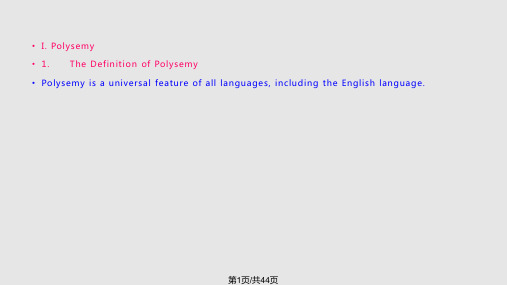
a. Beauty is but skin deep.
(abstract ) 美貌
b. She is a real beauty. (concrete
) 美人
a. Worry and suffering have
turned her hair white. (abstract ) 忧虑
第4页/共44页
There are also instances in which the primary meaning became either obsolete or disappeared, while the derived meanings become prevalent, such as “harvest” and “pain”.
(木板) wall, floors, boats, ship’s deck , etc.”
The last meaning is “a committee, group of persons controlling a
(董事会) business or a government depar tment”.
(Example whereas the derived meaning is widely used instead. on next page)
第16页/共44页
pen→ originally from pinna
(Latin), meaning “feather”; derived meaning “an
第5页/共44页
The primary meaning of the
word harvest was “autumn”,
because of the borrowing word “autumn” from French, people only use its derived meaning “reaping or cutting” in later time.
英语词汇学课件1-6章

1) Old English
族
古英语
vocabulary(450—1150 AD公元)
日耳曼语
After Romans罗马, 3 Germanic tribes called Angles , Saxons and Jutes controlled England. Their language—Anglo-Saxon also dominated 支 配 the land. Common practice : combine 2 native words to create new words. It was a highly inflected language with about 50000-60000 words.
3) Modern English 近代英语(1500---now) 2 sub-periods 子周期can be divided: a. Early Modern English (15001700) Because of the Renaissance , many Latin and Greek words entered English and English began to have a Latinate flavor拉丁味.
• C. Productivity衍生(can form new words) • D. Polysemy 一 词 多 义 (various meanings, “book”; “man”: to man a dove) • E. Collocability搭配( form idioms方 言, proverbs谚语)
It has something to do with与有关 the following subjects:
英语词汇学课件chapter 6

6.1.3 Two Processes of Development The development of word-meaning from monosemy to polysemy follows two courses which are called radiation and concatenation.
(3) Homophones are words identical only in sound but different in spelling and meaning, e.g. dear /diə/ n. a loved person deer /diə/ n. a kind of animal
6.2 Homonymy
They are words different in meaning but either identical both in sound and spelling or identical only in sound or spelling.
6.2.1 Types of Homonyms Based on the degree of similarity, homonyms fall into three types: perfect homonyms, homographs and homophones. (1) Perfect homonyms also known as absolute homonyms are words identical both in sound and spelling, e.g. bank n. the edge of the river, lake, etc. bank n. an establishment for money business
english lexicology (英语词汇学)
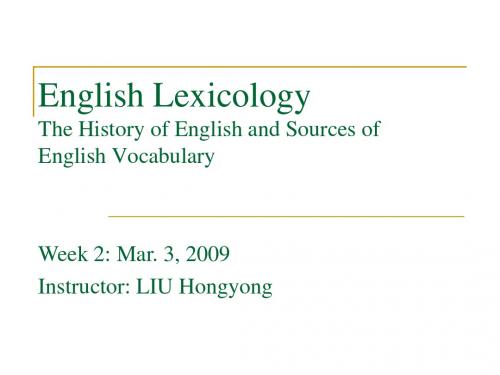
The Ger Germanic language that remained after the East Germanic split off developed into two new groups, North Germanic and West Germanic. The West Germanic group includes English. The North Germanic branch includes Viking Norse, which developed into Old Norse and eventually into modern Scandinavian languages such as Icelandic, Norwegian, Swedish, and Danish.
The Indo-European Family
Linguists have divided the Indo-European languages into several groups, or branches. For example, the Italic branch includes Latin and its descendants the Romance (‘originating in Rome’) Languages (Italian, French, Spanish, Portuguese, and Romanian), as well as other extinct languages. Other groups important in the history of English include Celtic (e.g., Welsh, Irish, and Scots Gaelic), Hellenic (Greek), etc.
词汇学chapterSix资料

Name
Definition
Property Example
Denotation
Reference
relation between a lexeme and a relation ships holds between an whole class of extra-linguistics expression and what the
• 2. Naturalists:
• 1) no intrinsic reason
• intrinsic correspondence
• 2) linguistic social contract
Relationship between a sound and its
meaning
• 3. homophones • write, right, rite
generally not applicable to single
word forms, never applicable to single lexeme. John’s computer – er to the specific computer o John.
6.3.2 Denotation and Sense
2. There is no such animal as a unicorn. There is no such book as a unicorn.
Contents (2)
• 6.4. Meaning Relations 6.4.1 Synonymy
6.4.1.1 Strict VS Loose Synonymy 6.4.1.2 Distinguishing Synonyms 6.4.1.3 Explanation for so many Synonyms
English Lexicology (Introduction) 英语词汇学 教学课件
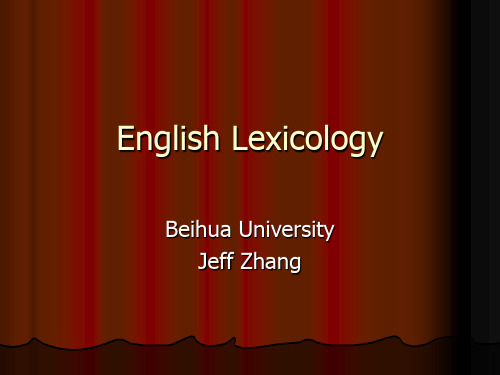
Its Relation to other Disciplines IV
Stylistics:
Stylistics is the study of style. It is concerned with the user’s choices of linguistic element in a particular context for special effects, including lexis, phonology, syntax, graphology.
Lexicology focuses on the lexical level, dealing with the types of meaning and sense relations such as :Polysemy, homonymy synonymy, Antonymy, hyponymy, and semantic field, which constitute an important part of lexicology
lexicology: the form , meaning , origins and usage of words. They have pragmatic differences. A lexicographer’s task is to record the language as it is used to so as to present the genuine picture of words to the reader, providing authoritative reference . While the student of lexicology is to acquire the knowledge and information of lexis so as to increase their lexical awareness and capacity of language use.
英语词汇学第6章

➢Synchronic approach共时研究方法
Synchronically, polysemy is viewed as the coexistence of various meanings of the same word in a historical period of time. 从 共时的角度看,在同一个历史时期,同一个 词可以拥有许多不同的意义。
• 2) Relative synonyms
Synonyms which denote different shades of meaning or different degrees of a given quality are called relative synonyms.
3. Sources of synonyms同义词的来源
➢ The basic meaning of a word is called the central meaning 中心意义. The derived meanings are secondary in comparison.
2. Two processes of development
1) Radiation辐射型 2) Concatenation连锁型
Ask
commenceascendFirefirm
conflagration
Fear
question
secure
Fast
mount
initiate
2) Dialects and regional English 地域性语言和方言
3) Figurative and euphemistic use of words 词的比喻和委婉用法 4) Coincidence with idiomatic expressions 单词与习惯表达在意义上的偶合
词汇学第六单元课件——词义的关系

exclusive and admit no possibility between them(相互反义) (non-gradable).
eg. A. like: mortal
immortal
male
female
dead
alive
B. Prefixes: dis-, in-, il-, ir-, im-, un-……
1) Complementaries绝对反义词 2) Contraries两极反义词 3) Conversives关系反义词 4) Semantic incompatibles多项不相容词
14
1)Complementaries绝对反义词
–These antonyms truly represent oppositeness. They are so opposed to each other that they are mutually
words ◆ d) Coincidence with idiomatic
expressions
8Leabharlann a)Borrowing.Native room foe help leave wise buy
Foreign chamber enemy aid depart sage purchase
9
b) Dialects and regional English,
16
2)Contraries(两极反义词/相对反义词)
–Antonyms of this type are best viewed in terms of a scale running between two poles or extremes. The two opposites are gradable.
Modern English Lexicology 6
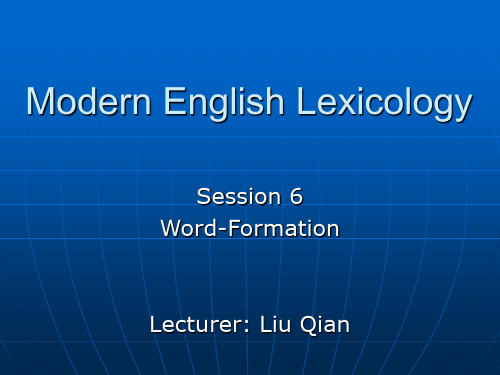
(17) Adverb + adjective: all-round, evergreen, overanxious
all-round athletes
(18) Past participle + adverb: made-up, grown-up
a made-up story/ heavily made-up eyelashes / a made-up mind
The home team was ahead 58-56 at halftime.
1.3 Classification of compounds
Compounding has always been a productive way of word-formation in English. It can be found in different parts of speech. 1.3.1 Compound noun The principal structural types of compound nouns are: (1) Noun + noun: lip service, night-school
Pay lip service to
(2) Adjective + noun: green-room, deadline, highway (3) Verb + noun: cutthroat, pickpocket, driveway
a band of cutthroats/pickpockets
a. Negotiation entails give-and-take.
b. They sat down for a lengthy give-and-take. a. a continual come-and-go of cars b. They are a come-and-go class of being, to whom the possession of furniture would be burdensome.
英语词汇学chapter6

2.The superordinate & the hyponym
(1) genus VS species
Genus: a class of things made up of two or more subordinate classes or species. For example, flower (genus): rose, tulip…(species).
(3) Semantically synonymous field(同 义语义场)
Base on semantic similarity, synonyms are usually arranged into synonymic groups or sets. Within this groups there is the most general term known as “synonymic dominant”(主导同义词). The synonymic dominant is the common denotational component that brings two or more words together into a synonymic group(同义词群), which can be called a semantically synonymous field.
The semantic field of food
hot dog, sandwich, hamburger 豆腐, 馒头
3. Synonymy
(1) Defining synonym
Synonymy is a term used in semantics to refer to a major type of sense relation between lexical items. Lexical items which have the same meaning but differ in morphemic structure, phonological form and usage are synonyms. The relationship between them is one of synonymy.
英语词汇学_Unit_06_Sense_relations

Synonyms Different In Collocation
accuse…of… vs. charge …with… Rancid vs. addled Rancid bacon/ butter Addled eggs or brains
1.2. source of synonyms
English has the most synonyms of any language in the world. Why are there so many synonyms in English?
Why are there so many synonyms in English?
Example
They made a decision to abandon the project. They decided to walk out on the project.
Synonyms with different connotative
meanings
Synonyms may have different emotive associations (connotative meanings). famous notorious misuse (disreputably) ambiguous equivocal new (deliberately) hate loathe obtain (with disgust) abuse (of privilege or power) novel (strikingly) procure (with effort)
Lexicology Unit 6
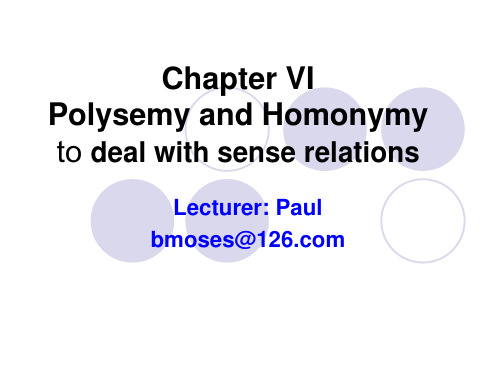
Lecturer: Paul bmoses@
On the whole, we can classify sense relations as follows: Synonymy and polysemy are relations between form and meaning, Synonymy: more than one form having the same meaning. Polysemy: the same form having more than one meaning. But homonymy: two or more words having the same form but different in meaning. Hyponymy下义关系 and antonymy 反义are relations between are two meanings: Hyponymy is the inclusion of one meaning in another. Antonymy is the exclusion of one meaning from another.). )
I.Polysemy .
Definition: (p.109) An example: the word “fair”, p.109. How can language do in order to reflect or express the new ideas, new process, new products? (p.110, para.3). Two approaches to polysemy a. diachronic approach: (p.110) -to study the growth, change or development in the semantic structure of the word in order to find the primary or original meaning of the polysemic word. Diachronically, we’ll try to find the primary or original meaning of a polysemic word.
- 1、下载文档前请自行甄别文档内容的完整性,平台不提供额外的编辑、内容补充、找答案等附加服务。
- 2、"仅部分预览"的文档,不可在线预览部分如存在完整性等问题,可反馈申请退款(可完整预览的文档不适用该条件!)。
- 3、如文档侵犯您的权益,请联系客服反馈,我们会尽快为您处理(人工客服工作时间:9:00-18:30)。
It is a productive device for the creation of new words since there is no restriction on the form.
In other cases, both splinters are the beginnings of words, e.g. sitcom (from situation + comedy).
The third type of blends consists of complete overlap, in which a part of the blend belongs to both words, e.g. sexploitation (from sex + exploitation), palimony (from pal + alimony).
It was time to brave the rush hour traffic again.
Adjective → noun: best, poor, rich, blind, convertible, daily, double, e.g.
I’ll do my best to help you.
In the formation of a blend, the first part of the first element is added to the second part of the second element. Most blends are nouns, but a few are adjectives such as glitzy (from glitter and ritzy), and verbs such as skyjack (from sky and hijack).
Adjective → verb: to better, to blind, to bold, to brave, to dirty, to empty, e.g.
The low sun blinded her as she drove up the hill.
You can use your bold to make the information stand out a little more.
You can adjust the blinds to keep out the glare.
I’d booked two single rooms, but they gave us a double.
Auxiliary verbs, adverbs, modal verbs, prepositions, conjunctions, interjections and even affixes can all act as bases for conversion, e.g.
Among the different types of conversion, the formation of a verb by converting a noun, adjective or other word is very common. For example, the noun chair becomes the verb to
The fourth type of blends is involves the embedding of one word in another, e.g. entreporneur (from entrepreneur + porn).
A very small number of blends consist of three source words, e.g. intelevisionary (from Intel + television + visionary).
He downed his beer and left.
The company has had its share of ups and downs.
Good binoculars are a must for any serious birdwatcher.
Are you out to your parents?
Although it is very difficult to tell which form arose first, these two types of conversion do exist.
Sometimes when a word consisting of two or more syllables undergoes conversion, there is a change in the stress pattern.
Some of the most common words include access, aim, bed, beer, brave, clean, cup, deck, e-mail,Байду номын сангаасfool, impact, pension, ship, train and so on.
The formation of a noun by converting a verb, adjective or other word is also very common. This process is often referred to as a type of nominalization.
For example, the verb run is used as the noun run, as in I went for a run after work. This type of nominalization is widely used as one of the most flexible and creative linguistic devices in English.
Among the better-known blends are smog (from smoke and fog), fruice (from fruit and jiuce), glasphalt (from glass and asphalt), modem (from modulator and demodulator) and urinalysis (from urine and analysis).
Verb → noun: a call, a command, a count, a go, a guess, a look, a walk, e.g.
Don’t try to eat the whole thing in one go. Hold your breath for a count of ten. Can you wait while I make another call?
English Lexicology
Lecture Six
Other Word-formation Processes
Conversion Blending shortening
Conversion
A change in word class without the addition of an affix is known as conversion.
Blending
Blending refers to the process of combining parts of two words to form a third word which contains some of the meaning of each part. Blends are compounds that are less than compounds.
chair, as in ‘chair the meeting’. This process is
known as a type of verbification.
This type of verbification often involves simple conversion of a non-verb to a verb. Verbified words are often found in colloquial English, where the speaker needs to describe common actions or experiences.
There are four major kinds of conversion: from noun to verb, from verb to noun, from adjective to noun and from adjective to verb.
Noun → verb: to air, to arm, to bottom, to cup, to fish, to mouth, to tooth, e.g.
Blends are often found in advertising, product names, and magazine and newspaper headings. Blending often results in the creation of new morphemes or in the addition of new meanings to old ones.
Structurally, there are four common types of blends.
